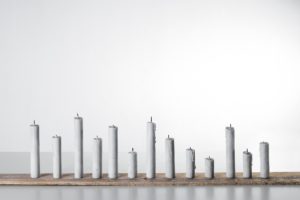 Sottile artificio linear
Sottile artificio linear
Valeria Vaccaro
2017
white marble and inks
32 cm x 15 cm x 155 cm
The installation „Sottile artificio linear” by Valeria Vaccaro contains thirteen white round candles, aligned next to each other. All had been lit, since their wick had burned black, and wax had run down the cylinders. However, they have all a different height. Therefore, they should have been lighted for different durations.
Already in ancient times the Cro-Magnums used lights with a wick, but the flammable substance was probably tallow or something similar. During the ages the candles were developed by the use of tallow, fat or waxes from plants or animals, with wicks made of cane, hemp or papyrus, which were dipped in the liquid. Only in the early 19th century the in nowadays common stearin candle was invented. Regardless, the used materials, candles provide light and also heat. Moreover, they were used to measure time as a candle clock. In religious contexts, the wax lights are also applied to symbolise the passing time of a festival or the time of preparation for one. In the Christian-Lutheran tradition, the round Advent crown contains four candles, which are lit in the four Christmas preceding weeks, every week one more. Whereas in the Jewish tradition of Hanukkah, every day of the eight days lasting Festival of Lights one more candle is lit. Correspondingly, the Hanukkah menorah has eight lights or sometimes nine. Traditionally all are aligned next to each other, but the ninth one stands a little bit offset on a higher or lower plane. It is called the shamash (“helper” or “servant”), which is used to light the other eight.
Even though, in Valeria’s installation the candles are aligned to each other, it is far of being a Hanukkah menorah, since there are 13 candles and no shamash. Or is it perhaps an amalgamation of Hanukkah menorah and Advent crown in a secular artwork, because there are nine plus four candles? Nevertheless, despite not being a candle clock, „Sottile artificio linear” refers to time. With their already burned wicks, the wax lights have a past. Their current condition is the normally volatile present and the future what might come. Since the candles have various heights, their presumed future would be shorter or longer.
However, Valeria has not contented herself in aligning wax lights on a board. In reality, the candles are made from white marble, painted with different inks. They are only the illusion of candles, even though they are a realistic reproduction. Thus, the artist has eternalised the ephemeral moment of the present.
At the same time, Valeria illustrates contrasts. First of all, she utilises rigid marble instead of the soft and easy shapable wax or stearin. Another opposition is also generated by the material: As already described, real candles are associated with light and heat. Whereas marble is cold and non-combustible. But this is exactly why „Sottile artificio linear” can surmount the transience.
Valeria Vaccaro
Born in 1988 in Turin, Italy, Valeria Vaccaro went to the Fine Arts High School in her hometown. Then, she studied sculpture at the Accademia di Belle Arti also in Turin. Early, in 2005 she presented her works to the public. Since this time, she participated in many group shows and art fairs, primarily in Italy. With the itinerant Biennale Jeune Création Européenne (JCE) from 2013 to 2015, her creations travelled throughout Europe, with shows in France, the Netherlands, Germany, Lithuania, Slovakia, Hungary, Austria, Spain and Portugal. She won a special mention from the city of Turin for the occasion of the 2017 Art Prize CBM. In 2022, she was granted with the second place of the VAF Foundation Award in Kiel, Germany.
Valeria explores in her hyper-realistic oeuvre fire and combustion, even though she only depicts the impact and does not work directly with the often destructive element. For her, fire is rather a purifying matter of inspiration, which transforms material. Interesting from this point of view is that her feedstock is a relatively fire resistant one: Carrara marble.
The artist transforms the white stone into seemingly other materials. Often she features items of everyday use, such as candles (our Artwork of the Month / December 2022), matches, transport boxes, furniture or as in our Artwork of the Month / November 2019 EUR-pallets. By processing the marble and painting it afterwards, emerge objects that portray the models perfectly. Common to these natural reproductions is that they carry traces of combustion, but the flame remains invisible. Herewith, she freezes a single instant between ideal condition and disintegration, to deliver it to eternity. A special appeal in these sculptures lies in the contrast of the simulated materiality and the real one.
Valeria lives and works in Turin.
